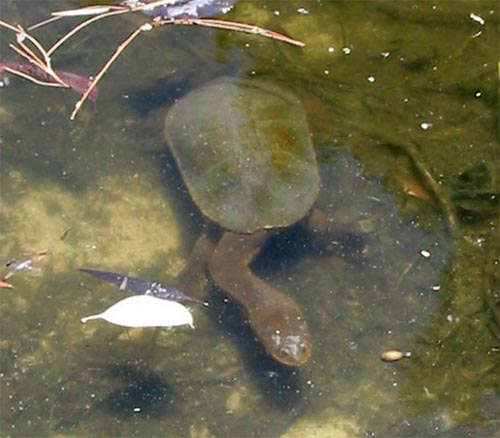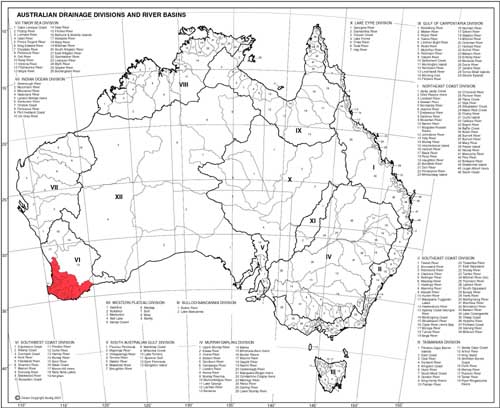Oblong Turtle -- Chelodina oblonga
[3]
 It is covered with warts. The head is flat, with a protruding nose, and
up to a dozen barbells in the chin area. The dorsal skin parts are brown or grey
with bits of brown while the ventral skin parts are pale gray. Dorsal side
of the neck and mouth can be creamy yellow or bone white.
It is covered with warts. The head is flat, with a protruding nose, and
up to a dozen barbells in the chin area. The dorsal skin parts are brown or grey
with bits of brown while the ventral skin parts are pale gray. Dorsal side
of the neck and mouth can be creamy yellow or bone white.
Unlike the oblong carapace of adults, the carapace of juveniles is pear
shaped when viewed from above. It is either grey or brown with dark spots
all over its surface and a yellow rim at the outer edge of the marginal
scutes. The plastron of hatchlings is black or steel gray, the ventral parts
are yellow, beginning under the distinctive snout and extending along the
neck to the body cavity. (Cann, 1998) The dorsal skin parts are gray except
for the head which can have yellow tinge.
Right photo: Chelodina oblonga in its natural habitat
There is a division through the eye, a character which can be seen in some
Emydura or Elseya species, but not in other Chelodina
or Macrochelodina species. The species has musk glands which are
used to exude a yellow, strong-smelling, liquid when a specimen feels to
be in danger. (Bradsell et al., 2002) C. oblonga is the only species out
of the Chelodina and Macrochelodina genera to have well developed neural
bones forming a contiguous series (Thomson & Georges, 1996). It was thought
the Australasian Chelidae had no neural bones until Burbidge et al. (1974)
reported neurals as a consistent feature of Chelodina oblonga.
Females are larger with shorter tales while males have a concave plastron, shallower carapace and a longer and thicker tail.
Distribution
Chelodina oblonga lives in lakes and lagoons in the south-west of Western Australia. Its distribution ranges from the Hill River in the north, down south to the Blackwood River, and further east to the Susetta River (Fitzgerald River National Park). (Cann, 1998) At some places, the species can occur in sympatry with Pseudemydura umbrina, Siebenrock, 1901.
Bottom photo: Distribution map of Chelodina oblonga
 Natural habitat
Natural habitat
The south-west of West Australia is notable for its many
estuaries with intermittent (sand-barred) connections to the sea and for
its thousands of freshwater (and many salinised) lakes, swamps and damplands.
Many of these waters are inhabited by Chelodina oblonga which lives
in lakes, lagoons and some rivers. What's more, the species is known to
tolerate, but only for short periods, brackish and even saline water with
salinity levels as high as 13 200 mg/L. (Chapman and Newbey, 1995) The waters
inhabited by C. oblonga include Thomson Lake, Bibra Lake, Perry
Lakes, Lake Monger, Blue Gum Lake, Booragoon Lake, Piney Lake, Little Rush
Lake, Yangebup Lake, Kogalup Lake, Bangenup Lake, and many others.
The south-west of Western Australia has a Mediterranean climate, with warm
to hot dry summer and cool wet winter. February is the hottest month of the year with an average maximum temperature of 30.0°C while July is the coolest month with an average maximum of 17.4°C. Mean minimum temperatures range from 9.0°C in July to 18.1°C in February.
Average annual rainfall is about
800mm. Most of the precipitation occurs from May to September.
The period from November to April is hot and dry. As a result, many water
bodies dry out and some C. oblonga specimens aestivate by burying
themselves in the drying mud for 5-6 months. (Kuchling, 1988, 1989) Other
specimens prefer to search for a permanent water body.
The temperature at the waters inhabited by C. oblonga ranges between
18°C in summer (south hemisphere time) to 25-26°C in winter. For
example average water temperature at Booragoon Lake is 22.6°C in February
to March and 20°C in September to October. The highest recorded water
temperature is of 29.5°C. (Fox et al., 2004) As for the pH, a study of
41 wetlands on the Swan Coastal Plain, which contains a lot of lakes inhabited
by C. oblonga, found that the majority were alkaline, with a pH greater
than 7. (Fox et al., 2004) In captivity, the species should be kept within
the pH range of 7.0 to 8.5.
In their natural habitat, especially hatchlings are subject to predation. Marron (Cherax tenuimanus), koonacs (C. preissii - freshwater crayfish native to Western Australia) and yabbies (Cherax sp.), but not gilgies (C. quinquecarinatus), showed aggressive and predatory behaviour towards the hatchlings. "In total, 59 attacks were observed in 26 of the 80 trials. On 12 occasions, crayfish captured hatchlings in their chelae. On two occasions, the attack of the crayfish was so quick that the hatchling was killed instantly. Compared with movement when alone, movement of hatchlings was significantly greater in the presence of koonacs and yabbies, but significantly less in the presence of marron and gilgies." (Bradsell et al., 2002)
Adults of C. oblonga are also subject to predation with the introduced red fox (Vulpes vulpes) acting as the main predator.
